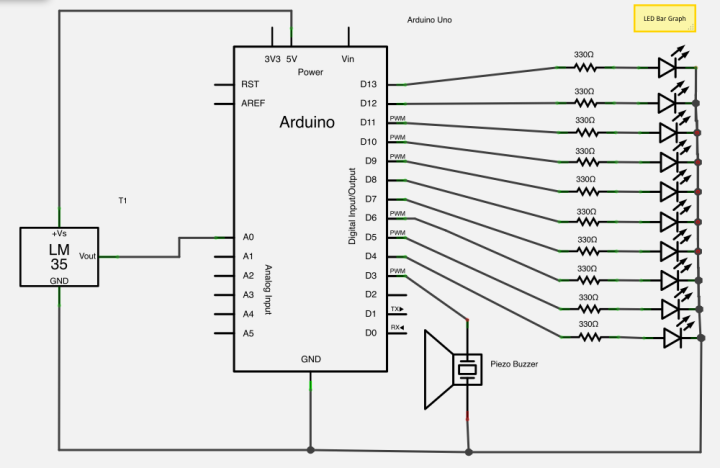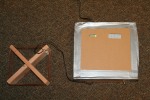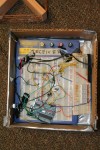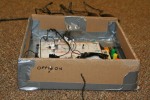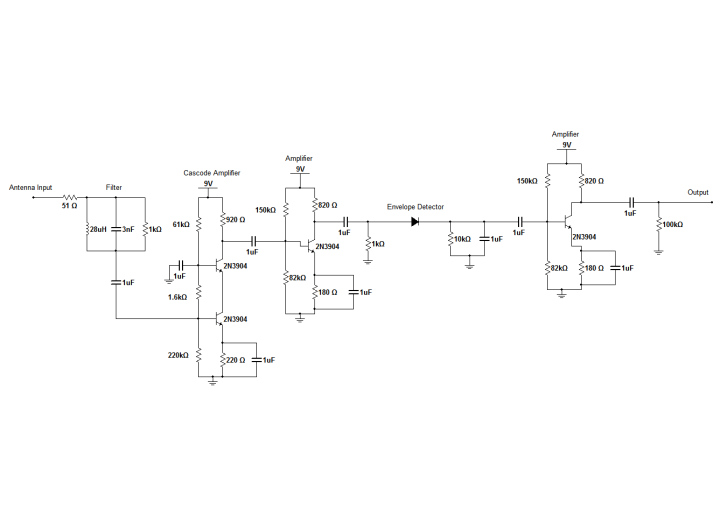arduino
Arduino Temperature Monitor
StandardThe semester is finally coming to a close which means I might finally get a chance to breathe deeply again and write about all the projects I’ve been working on this semester. This past week I’ve been finishing up a few smaller projects for my Electronic Design Lab course. I’ve really enjoyed getting to build stuff this semester and apply some theory in real life. (Who knew!) One of these projects I have been working on is a module which senses the ambient temperature using an Arduino and some output LEDs (eventually an LCD when I get around to buying one) to display this information. I’m hoping to be able to continue this design and make a more permanent version for some other ideas I have.
I used some CAT5 ethernet cable as an extension for the temperature sensor so as to allow for the actual sensor to be placed a distance from the Arduino unit. For the display unit, I used a 10 LED bar graph module and hooked the LEDs up to the digital output pins using 330 ohm resistors. I also connected a piezo buzzer to one of the PWM pins so as to allow for an alarm.
The physical layout for the device is below:
The schematic:
The code for the Arduino is pretty simple, taking the input temperature from the LM35 sensor in the form of an analog voltage value and converting it to a digital value and finally to a temperature using the equation for the LM35: 
Then, this value is converted to degrees fahrenheit and the result printed to the serial monitor. Following this, the value is mapped to the number of LEDs using the baselineTempF and maxTempF values declared as global variables at the beginning of the sketch. Using this value, a for loop is entered in which the appropriate LEDs are turned on and all others turned off. A piezo buzzer is also connected on pin 3 as an alarm if the temperature rises above a user-configured value, or if the temperature is above or below the set range of detection.
The complete code is attached here.
The prototyped version of the device looks like this:
 The Arduino with Bar Graph LED and LM35 Sensor
The Arduino with Bar Graph LED and LM35 Sensor
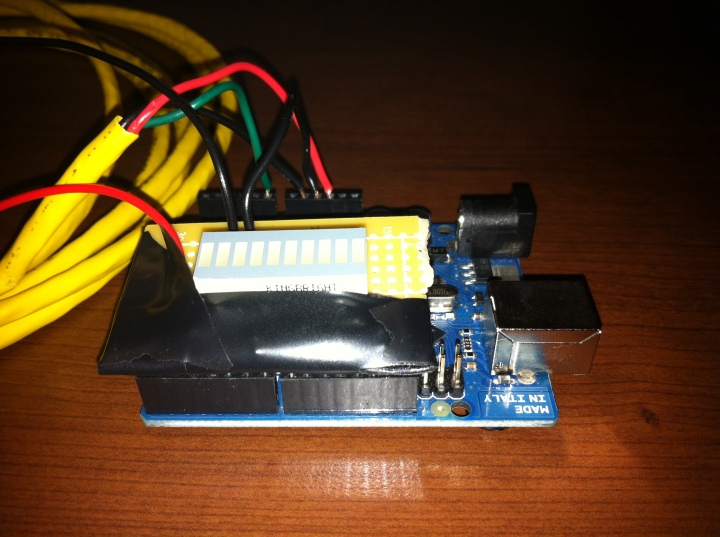 Arduino and LED Bar Graph Close Up
Arduino and LED Bar Graph Close Up
LM35 Sensor Cable Close Up
Future plans for this include creating a more permanent module with the Arduino integrated onto a PCB or protoboard, extending the sensing functionality and precision of the device, and adding additional methods to output the data. Please leave your questions or comments!
Electronics 1 Project: Wireless Remote Help Station
StandardLast semester for my Analog Electronics I class we were required to complete a project using a form of radio communication. The project was very open ended, but the goal was to create a product which could be used to be used in a service oriented application. While this requirement was vague, we narrowed the project scope and decided to create an wireless, itemized help request system for someone in a limited mobility situation to contact help. Throughout the course of the project we learned a great deal about radio transmission, amplifier design, and antenna design. Here are some pictures of the final product as well as some shots from along the way.
The transmitter consisted of a square wave oscillator circuit using an LM741 Op-Amp, a Colpitts Oscillator, a modulator, and an amplifier. By switching in different resistance values in parallel with the resistance value which created the base frequency, the frequency of the square wave generated by the LM741 Op-Amp could be changed. This signal was then modulated using a 2N3904 BJT with a carrier sine wave with a frequency of about 550 kHz. After this stage the signal was then amplified and sent to the antenna.
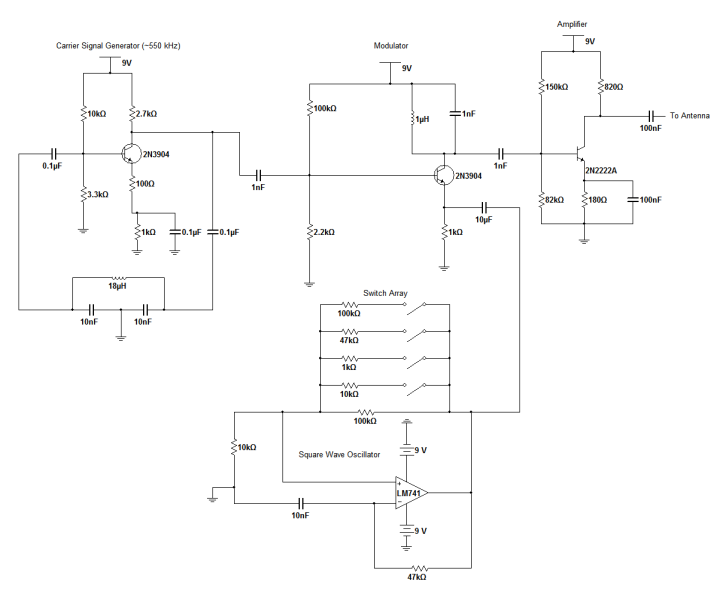 On the receiver side, the signal passed through the antenna and then was filtered to remove any unwanted frequencies. After the filter, the signal was sent through a cascode amplifier and cascaded through another common emitter amplifier. After this initial amplification, the envelope detector was next. The envelope detector essentially uses a diode and an RC network to filter only the positive side of the signal and to filter out the high frequency carrier, passing only the square wave data signal. It is important to note that the signal must be strong enough to overcome the internal 0.7 V bias of the diode in order for the detector to be effective. Finally the signal was amplified once again and the output transmitted to an Arduino Duemilanove for decoding.
On the receiver side, the signal passed through the antenna and then was filtered to remove any unwanted frequencies. After the filter, the signal was sent through a cascode amplifier and cascaded through another common emitter amplifier. After this initial amplification, the envelope detector was next. The envelope detector essentially uses a diode and an RC network to filter only the positive side of the signal and to filter out the high frequency carrier, passing only the square wave data signal. It is important to note that the signal must be strong enough to overcome the internal 0.7 V bias of the diode in order for the detector to be effective. Finally the signal was amplified once again and the output transmitted to an Arduino Duemilanove for decoding.
Now that you’ve had a chance to see what the actual device looks like and the schematics it’s time for some theory! The radio transmission method we used is called Amplitude Shift Keying (ASK). Essentially, the amplitude of some data signal (a square wave in our case) is modulated or combined with a high frequency carrier wave which allows the signal to travel through the air. Then, the receiver takes the signal it receives at its tuned frequency and demodulates it to regain the data signal (square wave). Finally, this signal is processed and an action performed. In our project, we used an Arduino Duemilanove (arduino.cc), a popular open source microcontroller, to process the frequency of the square wave and light up certain display LEDs on the panel to indicate which switch was activated at the input. This provided flexibility in our design, allowing us to customize the frequencies for each setting on the fly and also do some simple signal processing. Although the quality of our homemade antennas crippled the range of our system, this project provided us with a practical application of antenna theory, radio transmission, and most importantly, transistor theory.
Thanks for reading and please feel free to leave questions or comments!

